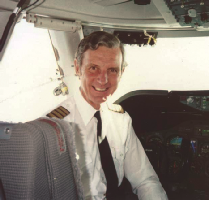





On Laughter-
I first flew as an ATC cadet in 1948 having grown up in southern England during the war and watched, fascinated and wondrous, the con-
England during the war and watched, fascinated and wondrous, the con-
I was to join the RAF myself and become a fighter pilot and was posted to the Middle East to 208 Squadron which had flown Spitfires but now were equipped with Meteors. The Spits had long since gone, giving way to the jet age. Some years later I was posted to RAF Woodvale as a flying instructor with a University Air Squadron. I inherited the grand title of Chief Harvard Instructor (nobody else wanted the job) but I liked the Harvard. It was an excellent training aircraft and I used to joke that it had taken me six years flying to get from the front seat to the back seat of a Harvard! It was to prove invaluable.
Woodvale was a delightful airfield situated between Southport and Formby in Lancashire, overlooking the shallow waters of the beach famous for the horse drawn carts of ‘shrimpers’ who would later ply their delicious potted shrimps. Woodvale was home to two University Air Squadrons, Meteors of 611 Auxiliary Squadron (later disbanded) and the THUM Flight. The task of the THUM Flight (the initials stood for Temperature and Humidity) was to gather daily weather information from the upper atmosphere. The aircraft had to climb in steps to be at 30,000ft at a point just north of Worcester (deemed to be the middle of England). The aircraft designated this task was none other than the PR19 Spitfire. The THUM Flight was an unusual unit in having RAF Spitfires but flown by civilian pilots (ex RAF) on contract to the Short & Harland Company. One of the pilots was ex Squadron Leader John Formby, nicknamed ‘George’ after the famous singer and ukulele player of the time. I got to know ‘George’ well and as it was every young pilot’s dream to fly a Spitfire I would envy his daily flights, landing at Speke (Liverpool) to deliver his reports before flying on to Woodvale. We discussed the possibility of my obtaining official permission to have a fly in his Spitfire. No chance! The dream, so close, would have to remain just that. Then in late 1956 came the news that the Spitfires were to be withdrawn.
The morning of 16 September 1956 dawned bright and clear. It was Battle of Britain Sunday and a Commemorative Service was to be held in Formby’s church. All were to attend; best ‘blue’ uniform to be worn. The Station could not be left unmanned: the Duty Officer would remain and as it was, by chance, my turn to be Orderly Officer, the lot fell to me. I sat alone in the Flight Office which overlooked the airfield and watched as ‘George’ landed from his mission and taxied in. I strolled over to the hangar where he had parked to have a natter and, as always, bask in the glory and beauty of the Spitfire glinting in the sun. Tempting! As I stood there on Battle of Britain Sunday in my ‘best blue’, before the aircraft of all aircraft, I think we both recognised the inevitable: I was going to fly PS915.

